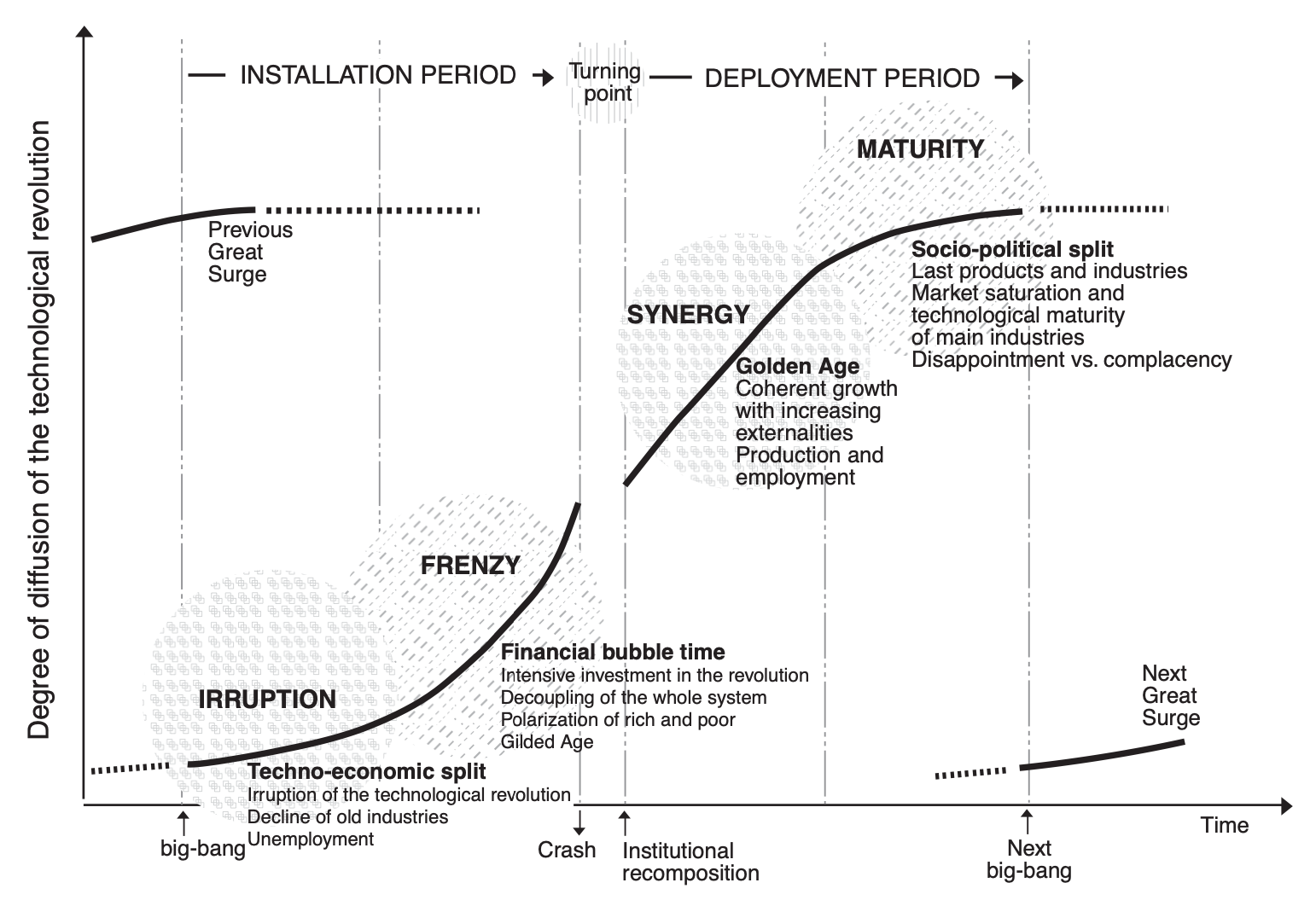Technological Revolutions and Financial Capital
A framework for technological paradigms
The main claim is that technology has progressed in succeeding and distinct waves/paradigms since the Industrial Revolution and has done so for financial and social reasons rather than technological ones.
Paradigms progress in phases:
- Irruption: A technological revolution - technology with the means to modernize all existing industries and activities - irrupts into the scene. Production capital (entrepreneurs, operators) realizes the opportunity - often after a highly visible attractor event (e.g., ChatGPT) - and starts building to make it increasingly clear to the rest of the world.
- Frenzy: Financial capital (venture capital and the rest of finance) aggressively pursues this technology, enabling production capital. A financial bubble forms because financial expectations grow faster than real deployment, partly because of societal inertia slowing adoption and partly because of financiers’ unrealistic expectations and speculation. Social/political tension builds up because of growing inequalities between leaders of the revolution and everyone else.
- Bubble/crash/turning point: The financial bubble and political tension lead to a crash. New institutions and regulations are introduced to address tensions.
- Synergy / golden age: Production and financial capital converge - with production capital as the leader and financial capital as the enabler - to fully exploit the wave’s potential across all industries and activities, raising everyone’s productivity and life standards.
- Maturity: The wave’s potential nears exhaustion with saturated markets. A new generation of production capital wants to leave its mark on the world. Idle financial capital looks for the returns it’s been used to in new places, backing the irruption of the next paradigm.

Why is there a single dominant paradigm at a time?
- because the backing of financial capital for the technology that provides the best returns leads to a self-reinforcing loop until the exhaustion of its potential
Why are there crashes mid-paradigm?
- financial bubble
- inertia: society adopts technology slower than it is developed
- unrealistic expectations and speculation: financial expectations grow faster than real deployment
- social/political tension: inequalities grow between leaders of the revolution and everyone else
Past technological paradigms
From the perspective of 2002, when the book was written:
| Paradigm | Date | Leaders | Cheap input | Crash |
|---|---|---|---|---|
| Industrial revolution | 1770s-1820s | Britain | Cotton? | 1790s canal mania |
| Steam & railways | 1830s-1870s | Britain, spreading to continent and USA | Coal | 1840s railway mania |
| Electricity, steel & heavy engineering | 1870s-1910s | USA/Germany overtake Britain | Steel | 1893 panic |
| Oil, automobile, mass production | 1910s-1970s | USA, spreading to Europe, Japan | Oil | 1929 great depression |
| Information, computing, software | 1970s-?? | USA, spreading to Asia, Europe | Microprocessor | 2000 dotcom bubble |
Where are we today?
My take is that we can complete the table as follows:
| Paradigm | Date | Leaders | Cheap input | Crash |
|---|---|---|---|---|
| Information, computing, software | 1970s-2020s | USA, spreading to Asia, Europe | Microprocessor | 2000 dotcom bubble, 2008 financial crisis |
| AI, deep tech | 2010s-?? | USA & Asia, spreading to Europe, Africa | Digital data | ?? |
Maturity of the age of information, computing, and software
What were its main features?
- Internet: archive and instant search of humanity’s knowledge from anywhere
- personal computing: personal computer, smartphone
- business computing: cloud computing, SaaS
Why are we in the maturity phase?
- markets are approaching saturation
- more than 5 billion people already have a smartphone and/or personal computer with Internet access
- most low-hanging SaaS opportunities have been built already
Irruption of the age of AI and deep tech
AI is the foundation of the current paradigm
- it irrupted with deep learning in 2012 enabled by the previous paradigm: Internet data + cloud computing
- it has the potential to automate the very foundation of what gives humanity its power over the physical world: our intelligence and ability to create knowledge - this is more powerful of an enabler than any of the technologies driving previous paradigms
- we might be entering the frenzy with the amount of VC money being poured into LLMs
If we handle it well, it will make humanity a lot more ambitious in all its endeavors in the synergy phase of the wave
- AI-driven personal computing: personal AI life copilot, coach, co-creator, teacher, friend, therapist
- AI-driven robotics: robots automating most physical labor, caring for aging populations and dramatically accelerating the pace of building anything
- AI-driven research and knowledge creation
- e.g., in energy, accelerate nuclear fusion development to address global warming
- e.g., in biology, dramatically extend human healthy lifespan
But the crash can be way more painful than any we’ve seen before
- labor market disruptions: in the short term, AI will automate large portions of today’s jobs, both intellectual and physical, leading to underemployed, insecure, and angry populations
- concentration of power for corporations: the best will enjoy compounding returns on intelligence (use ⇒ data + deployment experience + attract best engineers ⇒ better product ⇒ more use) and challenge nation-states
I have no idea what maturity would look like for this phase, let’s get there and see